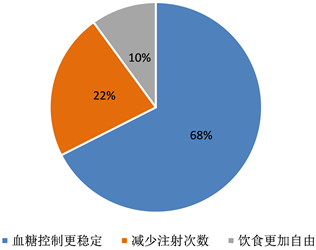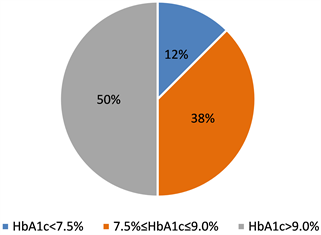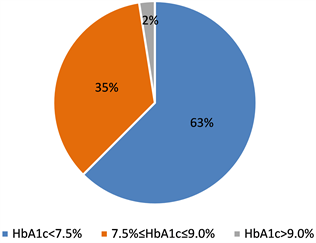摘要:
目的:探讨1型糖尿病(Type 1 Diabetes Mellitus, T1DM)儿童应用胰岛素泵(Continuous Subcutaneous Insulin Infusion, CSII)治疗的临床效果,分析院外CSII治疗过程中存在的问题,为CSII长期治疗的随访管理提供指导依据。方法:2019年1月至2019年6月对长期在青岛妇女儿童医院内分泌科门诊随访的使用美敦力722 CSII治疗6个月以上、年龄18岁以下且长期居住于青岛地区的40例T1DM儿童进行问卷调查,了解患儿糖化血红蛋白(Glycosylated Hemoglobin A1c, HbA1c)水平及治疗过程中出现的问题。结果:T1DM儿童经CSII治疗后HbA1c为(7.12 ± 1.11)%,较CSII治疗前HbA1c (9.58 ± 2.08)%显著下降,差异有统计学意义(t = 7.315, P < 0.05)。在治疗过程中,患儿出现皮肤并发症,有低血糖及酮症酸中毒发生。结论:T1DM儿童院外要达到最佳血糖控制效果,取得较为满意的临床疗效,不能单纯依靠CSII,科学、规范化的管理是极其重要的。
Abstract:
Objective: To investigate the clinical effect in children with Type 1 Diabetes Mellitus (T1DM) who used of Insulin pump (Continuous Subcutaneous Insulin Infusion, CSII) therapy, analyze the problems existing in the treatment of CSII outside the hospital and provide theoretical guidance for application of CSII in long-term therapy and follow-up management. Methods: From January 2019 to June 2019, 40 T1DM children with Medtronic 722 CSII for more than 6 months in the outpatient department of endocrinology of Qingdao women and children’s hospital, who were under 18 years old and lived in Qingdao for a long time, were followed up with questionnaires to the level of Glycosylated Hemoglobin A1c (HbA1c) and the problems in the therapy process. Results: The HbA1c was (7.12 ± 1.11)% in children with T1DM after treatment with CSII, which was significantly lower than the HbA1c (9.58 ± 2.08)% before CSII treatment. The difference was statistically significant (t = 7.315, P < 0.05). During the treatment, the child had skin complications, hypoglycemia and ketoacidosis. Conclusions: To achieve the best glycemic control effect and obtain satisfactory clinical efficacy outside the hospital, T1DM children cannot rely solely on CSII, scientific and standardized management is extremely important.
1. 引言
儿童青少年1型糖尿病(Type 1 Diabetes Mellitus, T1DM)是由于体内产生胰岛素的胰岛β细胞受到破坏,体内自身胰岛素绝对缺乏,必须终身使用胰岛素治疗,又称为胰岛素依赖性糖尿病,目前是严重影响儿童健康的慢性疾病。胰岛素泵(Continuous Subcutaneous Insulin Infusion, CSII)是目前最符合生理模式的胰岛素治疗 [1],在临床上应用越来越广泛 [2] [3] [4]。国内外多项研究均表明CSII能更好的控制血糖,减少血糖波动,有效降低糖化血红蛋白(Glycosylated Hemoglobin A1c, HbA1c),降低严重低血糖和酮症酸中毒的发生风险 [5] [6]。与院内短期CSII治疗不同,院外患者难以得到专业人员的及时指导,部分患者未能达到预期的治疗效果。因此,本研究对青岛地区院外使用CSII治疗的患儿进行长期随访,评价CSII的治疗效果,探讨CSII治疗过程中的问题,提高患儿治疗满意度。
2. 资料与方法
2.1. 一般资料
本研究的调查对象是40例T1DM患儿(均符合T1DM诊断标准 [7] [8])。患儿均长期居住于青岛地区、年龄在1~18岁、使用美敦力722CSII治疗6个月以上且长期在青岛市妇女儿童医院内分泌科门诊随诊。其中男21例,女19例;平均年龄11.2 ± 3.9岁;平均病程4.1 ± 2.9年;平均带泵时程2.7 ± 2.1年。
2.2. 调查方法
2019年1月至2019年6月对长期在青岛市妇女儿童医院内分泌科门诊随访的T1DM儿童进行问卷调查,问卷前充分对患儿及家长讲解调查的意义及注意事项,取得患儿及家长的知情同意。本研究获得医院伦理委员会批准(批件号QFELL-KY-2019-59)。调查问卷包括患儿的一般情况(性别、年龄、体重、病程、带泵时程等)及治疗相关资料(HbA1c控制水平、低血糖及酮症酸中毒发生频率、有无出现皮肤并发症及常注射部位等)。
2.3. 统计学分析
采用SPSS 21.0统计学软件进行数据录入及统计学分析。计量资料以
表示,对治疗前后HbA1c比较采用配对样本t检验;计数资料以例数(构成比) [n (%)]表示。P < 0.05为差异有统计学意义。
3. 结果
3.1. 青岛地区T1DM儿童CSII治疗效果
使用CSII治疗前HbA1c为(9.58 ± 2.08)%,根据2014年美国糖尿病学会(American Diabetes Association, ADA)推荐 [9],对年龄 < 18岁的T1DM患儿HbA1c控制目标为<7.5%,则其达标率为12.5%,其中HbA1c > 9.0%的比例高达50.0%。CSII治疗后HbA1c为(7.12 ± 1.11)%,总体控制水平良好,其达标率为62.5%,其中HbA1c > 9.0%的比例仅占2.5%,较CSII治疗前显著下降,对T1DM儿童使用CSII治疗前后的HbA1c进行比较,差异有统计学有意义(t = 7.315, P < 0.05)。详见图1、图2。

Figure 1. HbA1c in children with T1DM before CSII therapy
图1. T1DM患儿使用CSII治疗前的HbA1c情况

Figure 2. HbA1c in children with T1DM after CSII therapy
图2. T1DM患儿使用CSII治疗随访后的HbA1c情况
3.2. 青岛地区T1DM儿童接受CSII治疗的原因
40例患儿中27例(67.5%)患儿选择CSII治疗的原因是使血糖控制更稳定,9例(22.5%)患儿选择治疗原因是为了减少注射次数,4例(10.0%)患儿选择治疗原因是为了饮食更加自由,见图3。在CSII治疗过程中,其中有6例(15.0%)患儿对其产生过排斥,原因为活动不便、恐惧针头长期植入、影响社交,但仍选择继续治疗。

Figure 3. Reasons for TIDM children receiving CSII therapy in Qingdao
图3. 青岛地区T1DM儿童接受CSII治疗原因
3.3. 青岛地区T1DM儿童CSII治疗过程中存在的问题
在治疗过程中,有24例(60.0%)患儿出现皮肤并发症,其中17例(42.5%)出现硬结、疤痕,3例(7.5%)为皮肤过敏(发红、皮疹、瘙痒),4例(10.0%)为皮肤过敏合并硬结。30例(75.0%)患儿选择腹部为注射部位,10例(25.0%)选择注射部位为患儿臀部、上臂外侧。40例中有6例患儿出现过低血糖,其中2例每个月出现1~2次低血糖,4例每年出现7~9次。有2例处于青春发育期的患儿发生过酮症酸中毒。
4. 讨论
由于T1DM儿童需终身依赖外源性胰岛素进行降糖治疗,对于大多数家长来说难以接受这个事实,需要一定时间慢慢接受,加上患儿年龄小,认知能力及生活自理能力不足,不能独自对疾病进行治疗管理,很大程度上需要依赖家长,从而给家长带来沉重的精神负担和经济负担。
希腊一研究 [10] 对140例T1DM患者进行长期随访,研究表明使用CSII治疗后HbA1c由(8.67 ± 1.54)%下降至(6.85 ± 0.52)%。本研究结果显示,青岛地区T1DM儿童的HbA1c水平为(7.12 ± 1.11)%,总体控制水平良好,已接近国外水平,与2017年韩玉杰 [11] 青岛地区调查的68例T1DM儿童HbA1c水平(8.38 ± 1.55)%相比,血糖控制明显改善。
在CSII治疗过程中,有24例患儿出现皮肤并发症,主要表现为皮肤过敏(发红、皮疹、瘙痒),考虑患儿皮肤柔软娇嫩,易对胶布、敷贴材料等产生过敏,因而对皮肤敏感患儿可使用脱敏胶布减少过敏发生的几率,少部分患儿表现为皮肤硬结及疤痕,分析原因可能为患儿有恐惧心理,注射过程不配合,家长操作技术掌握不熟练,不能掌握注射深度等。因此,要与患儿充分沟通,做好患儿的心理护理及健康宣教工作,减少注射时的恐惧感,取得患儿的配合,在应用CSII治疗前,要对家长进行正规严格的培训以提高操作水平,腹部、臀部及上臂外侧等多部位更换注射以减少皮下硬结。
研究中有2例患儿在使用CSII治疗后发生过酮症酸中毒,2例患儿均处于青春发育期,分析可能原因为:到了青春发育期,一方面性激素拮抗胰岛素导致血糖波动大,另一方面生长迅速,每日营养需要量大,饮食较前增多,学习压力大,餐后运动少,体重变化明显,心理压力大,出现逆反心理,情绪波动大,对自己患病常感到自卑,治疗依从性降低,使糖尿病管理更为困难。对于在青春期的患儿,我们要密切关注心理问题,及时进行疏导,减少患儿与众不同感,增强他们自我管理的信心。虽然CSII可以更方便的调节胰岛素用量,但本研究中仍有6例患儿在CSII治疗后有低血糖发生,这提醒患儿及家属使用CSII并不代表能高枕无忧,仍要按时血糖监测,坚持规律运动,合理调整饮食。
CSII治疗费用高,消耗医疗资源多,治疗失败意味着高额的花费没有带来满意的疗效,而且严重的低血糖和酮症酸中毒可危及生命。分析原因在于患者没有真正掌握CSII的使用方法,对CSII认识不足,因此糖尿病教育和管理是非常重要的,加强患儿和家长对疾病的认识,熟练使用CSII技巧,有问题及时与医生沟通,才能充分发挥CSII的作用。